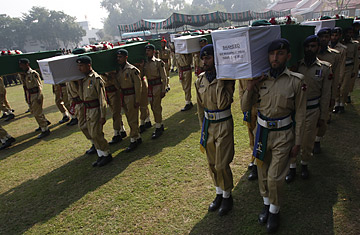
Pakistan army soldiers carry coffin of Saturday's NATO attack victims for funeral in Peshawar, Pakistan on Sunday, Nov. 27, 2011.
The NATO air strikes that killed 24 Pakistani soldiers last Saturday, sparking a fresh crisis in U.S.-Pakistan relations, started with a mysterious report of firing from the Pakistani side of the border, according to the Pakistan army's account of the incident.
Soon after midnight on Nov. 26, at about 12:05 a.m., a NATO sergeant called a Pakistani major at one of the border-control centers that the two sides use to coordinate their efforts to complain that U.S. Special Forces had received "indirect fire" from a Pakistani border checkpoint at Gora Parai, in Pakistan's Mohmand tribal agency. Seven minutes later, the NATO sergeant got back in touch with the Pakistani major to say that NATO forces had engaged a different location, the Volcano border checkpoint, also in Mohmand, some 15 km south of Gora Parai.
The details came during a briefing by Major General Ishfaq Nadeem, Pakistan's director general of military operations, to a select group of senior Pakistani journalists on Tuesday. Nadeem said that the NATO head of the border control center then told him the earlier report had been wrong. According to him, she said the firing had come from the direction of the Volcano border post on the Pakistani side.
The Pakistanis angrily deny that there was any firing from their side at either checkpoint. At the briefing, Nadeem denounced the NATO air strikes as an "unprovoked act of blatant aggression." But the question of who opened fire on the U.S. Special Forces on the Afghan side of the border remains unanswered and will help determine why NATO launched the air strikes.
There is also great confusion on the Pakistani side about why there were two episodes of NATO firing from the air, the second coming after senior Pakistani and NATO commanders had established communication and the helicopters had briefly pulled back, according to the Pakistan army's account. The first round of firing happened, Nadeem told the journalists, sometime between 12:15 and 12:30. Two or three NATO helicopters, he said, engaged the Volcano border post. The Pakistanis said they identified the presence of Apache helicopters.
When a second Pakistani border post a couple hundred yards north, called Boulder, saw the firing, it began to return fire at the helicopters using 12.7 mm anti-aircraft guns and regular fire. The firing from the Boulder post triggered a response from the NATO helicopters, which then began firing at both border posts.
The Pakistani army said that during this time, when NATO and the Pakistani border troops were exchanging fire, its border troops there opened up radio communication with NATO and pleaded that it was they, not Taliban militants, who were at the border posts.
Positioned at some distance behind the two Pakistani border posts was a company headquarters where other Pakistani army officers and soldiers were. Seeing the exchange of fire, Major Mujahid Ali of the Pakistan army rushed out to offer support to the Boulder border post but was killed on the way.
